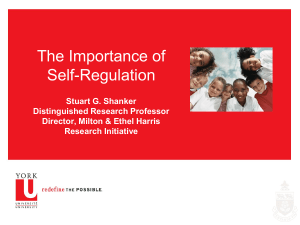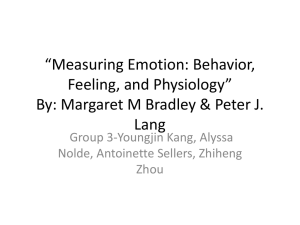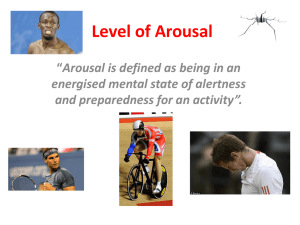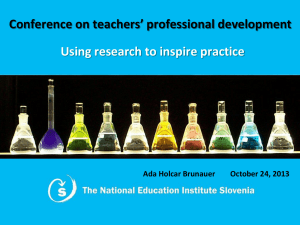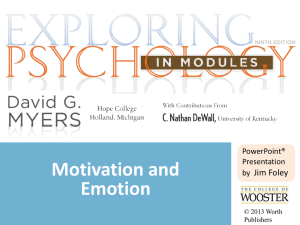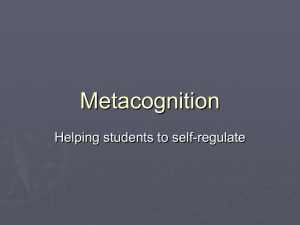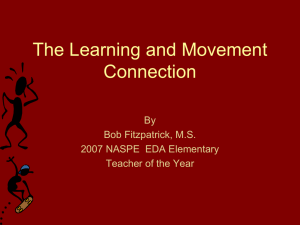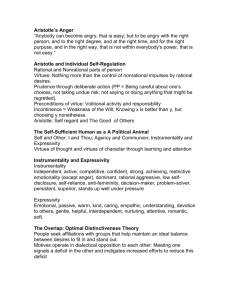Preschool Developmental Initiative Stuart G. Shanker
advertisement
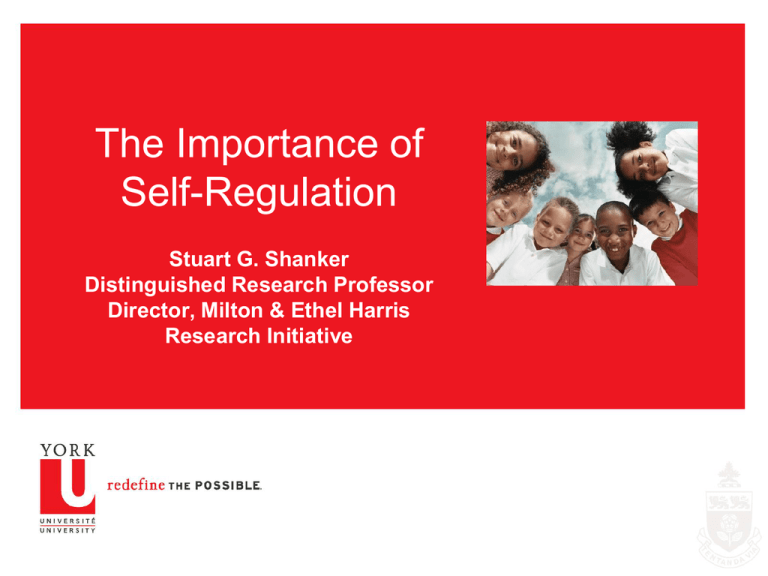
The Importance of Self-Regulation Stuart G. Shanker Distinguished Research Professor Director, Milton & Ethel Harris Research Initiative Delay of Gratification • Mischel’s famous‘marshmallow test: child is told he can have one marshmallow now or several if he waits until experimenter comes back • Around 30% of 4 year-olds can wait • The children who could wait scored an average of 210 points better on their college entrance exams • Not just academic achievement at stake: also predicts anti-social behavior and susceptibility to drugs (Mischel, Shoda & Rodriguez 1989) 2 Trajectories are Set Early • Mischel’s test is telling us that already by the age of 4 children are beginning to differentiate in terms of their self-control • Poor self-control, as early as the age of 4, can have a significant cascading effect • The big question is: Why are some children having so much more trouble controlling their impulses • And more to the point: What can we do about it?3 The Importance of Self-Regulation •Over the past decade there’s been an explosion of research on self-regulation in regards to a broad range of mental and physical problems •Each is thought to have unique biological antecedents and/or environmental contingencies, and to follow a different developmental pathway •Even within each disorder there is thought to be enormous variability in the pathways •But each is thought to involve a problem in self4 regulation, starting early in the child’s life Education Outcomes Developmental Disorders Internalizing Problems Externalizing Problems Cancer SelfRegulation Autoimmune disorders Cognitive Problems Cardiovascular disease Risky Behaviour Obesity What is Self-Regulation? • How a child responds to a stressor and recovers from the effort • All behaviors are self-regulating, but some impede social interaction and learning • Ideal state for learning to occur is when child is calmly focused and alert 6 Five Levels of Self-Regulation 1. Arousal: Environmental stressors (e.g., visual, auditory) 2. Emotion: Modulate negative and positive emotions 3. Cognitive: Sustain and switch attention 4. Social: Master the skills of co-regulation 5. Prosocial: development of empathy 7 Arousal Regulation (Level 1) Underpins the other 4 Levels of S-R •Arousal regulation is a function of Sympathetic Nervous System activation (e.g., adrenalin) and Parasympthetic Nervous System inhibition (e.g., cortisol) •In effect, putting your foot on the gas or the brakes in order to deal with a stressor 8 Continuum of Arousal Regulation • There is a continuum of arousal, ranging from sleep to being flooded • how much recovery is necessary or how much activation is needed for any particular task is going to vary from child to child and situation to situation 9 Stages of Arousal Inhibition 1. Asleep 2. Drowsy 3. Hypoalert 4. Calmly focused and Alert 5. Hyperalert 6. Flooded Activation 10 Driving Analogy •helpful for understanding the subtle adjustments in arousal involved in regulating attention •If goal is to maintain a speed of 100 km/hr constantly pressing and easing up on the gas depending on the state of the road, incline, wind speed etc. •Furthermore, driving involves constant changes in speed limits or traffic conditions, so learning how to drive involves learning how to smoothly adjust the 11 amount of gas or braking required for the current Optimal Regulation •Children vary considerably in their capacity for optimal regulation: i.e., their capacity to make gradual and rapid changes across the arousal continuum, recover back to baseline, and modulate the highs and lows of energy within a given state •Some children are constantly pushing too hard on the gas or the brake pedal, jumping erratically from one level to another, or not hard enough (Lillas & Turnbull 2009) 12 Allostatic Load Conditions •If child subjected to too much stress, the result can be an allostatic load condition: •Sudden transitions between energy states •prolonged over-activation of SNS and/or PNS •inappropriate activation of SNS or PNS (i.e., in situations not warranting a heightened stress response) • diminished ability to return to baseline after activation of the stress response 13 Consequence of Over-Exposure to Stress •Disrupts development of the brain (HPA pathway) •Child becomes chronically hypoaroused or hyperaroused •Child has difficulty staying focused and alert, which is the ideal state for learning to occur 14 Chronic Hypoarousal •Might be because of problems reaching a threshold to activate awareness of a stimulus •or because this serves as a defensive mechanism because child finds certain stimuli or experiences overwhelming; •Or because child has difficulty differentiating internal signals •Child finds it soothing to be in a hypoaroused state 15 Chronic Hyperarousal •Child might be highly sensitive to certain kinds of stimulus (internal or external) •he might be sensory craving and need to maintain a certain level of activity in order to feel fully aware of his body or to register certain kinds of sensation •he might be experiencing too many stressors and his parasympathetic system is in constant overdrive 16 Down-regulating and Upregulating a Child •caregiver’s regulating behaviors a function of the situation and her reading of the baby’s signals •E.g., if it is time for social interaction and the child is listless and nonresponsive she might up-regulate the baby by heightening the intensity of her smiles, vocalizations, gestures •If it is bedtime and the child is hyperaroused, with jerky movements or a wide-eyed stare, she might seek to down-regulate him via bath-time, story time, 17 singing a lullaby, stroking Sleeping •Sleeping is very much a self-regulating behavior, a critical way of restoring bodily functions, and an important part of the process of learning how to selfregulate involves learning how to register the visceral signals of fatigue and the need to lie down and restore •But a child who sleeps excessively as a mechanism for avoiding stress needs to be up-regulated, which means addressing the causes of the child’s distress 18 Self-Regulation and Self-Control •marked tendency to equate problems in selfregulation with poor self-control •To be sure, some children find it much more difficult to control their impulses •There is a strong tendency, dating back to the Ancient Greeks and Early Christian thinkers, to see these children as somehow to blame for their poor self-control 19 A Change in Attitudes is Imperative •We need a different understanding of why it is so difficult for some children to inhibit their impulses •That is, we need to understand why some children have so much more trouble learning the skills that support self-control, and what we can do to help them master these skills 20 Why it is so Difficult for Some Children to Develop Self-Control •Whatever a child is doing demands fuel, and the size of that cost will vary according to the activity, the situation, and most importantly, the child •two children might have to expend very different amounts of energy – be at very different points on the arousal continuum – in order to engage in the same activity •This can be due to biological, social, and/or environmental causes 21 Sitting in Class •Suppose we are dealing with a child who finds sitting in a classroom very demanding, for different reasons: •maybe he finds the visual and auditory stimuli distracting and he has to work hard to filter this out in order to pay attention to his teacher •or he finds the hard seat uncomfortable and it is taxing for him to sit still for too long 22 Cascading Effects •Suppose this child expends 40 l/100 km in order to master some new material while the child sitting next to him only expends 20 l/100 km •It is no surprise, given the tight interconnection between arousal and focus that the attention span of the first child will be much less than that of the second •But if the pace of the lessons is patterned on the attention span of the latter child, then the former is 23 going to fall further and further behind Energy Depletion Studies •Baumeister has shown in a number of experiments that attention to a task significantly depletes energy reserves •The greater the energy consumed by a task the greater the likelihood that child will shut down to try to restore energy churn out adrenaline to try to meet the demands of the situation), both states marked by decreased attentional capacity •Negative emotions (frustration, shame, anxiety) are 24 also a great drain Sources of the Problem •The problem is that some children have to work much harder than others to perform the same tasks, and it is this expenditure that so seriously depletes their capacity to meet subsequent challenges •A child who daydreams excessively or is inordinately hyperactive is certainly not culpable in any way, and it would be deeply unfortunate to treat the child as if he were, however unconscious this might be •we need to understand and thereby mitigate the 25 drains on their nervous system The Effects of Excessive Stress •What studies show is that some children are dealing with far too much stress in their lives, because of biological, social, psychological, and/or environmental reasons •These children have to work much harder to pay attention, and an allostatic load condition is going to get ever more entrenched as the negative effects caused by falling further and further behind or having greater and greater social problems exacerbate the 26 drain on their already over-stretched nervous system Understanding a Child • self-regulation is critical for enabling a child to engage in those social experiences that enable her to learn the cognitive and emotion-regulating skills that underpin self-control • A child who has difficulty engaging in these critical social experiences because of the drain on his nervous system can indeed be helped; but only if his or her needs are first understood 27 Early Indicators Must Not be Ignored • Problems in self-regulation, leading to poor selfcontrol in a young child, can have a seriously cascading effect in all domains: physical, social and psychological • This is what the graphic is telling us 28 Readings Lillas, C & J Turnbull (2009). Infant child mental health, early intervention, and relationship-based therapies. WW Norton. Shanker, SG (2012) Calm, Alert and Learning: Classroom Strategies for Self-Regulation. Pearson. 29
